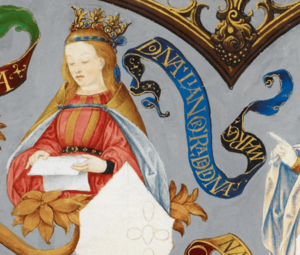Eleanor of Portugal, Queen of Denmark facts for kids
Quick facts for kids Eleanor of Portugal |
|
|---|---|

Eleanor in António de Holanda's Genealogy of the Kings of Portugal, c. 1530–34.
|
|
| Junior queen consort of Denmark | |
| Tenure | 1229–1231 |
| Born | c. 1211 Kingdom of Portugal |
| Died | 28 August 1231 (aged 19–20) Denmark |
| Burial | St. Bendt's Church |
| Spouse | Valdemar the Young |
| House | Portuguese House of Burgundy |
| Father | Afonso II of Portugal |
| Mother | Urraca of Castile |
| Religion | Roman Catholicism |
Eleanor of Portugal (born around 1211 – died August 28, 1231) was a Portuguese princess. She was the only daughter of Afonso II of Portugal, who was the King of Portugal, and Urraca of Castile. Eleanor became the Queen of Denmark in 1229. She married Valdemar the Young, who was the son of King Valdemar II of Denmark.
Becoming Queen of Denmark
The idea for Eleanor's marriage to Valdemar the Young came from Bishop Gunner of Viborg. This marriage made sense because Eleanor's aunt, Berengaria, had been Valdemar the Young's stepmother. This connection helped arrange the royal wedding.
The wedding ceremony took place in Ribe, Denmark, on June 24, 1229. The very next day, Eleanor received a special wedding gift from her husband. She was given the southern part of the island of Funen. Even though she was called the "junior queen," she was actually the only queen in Denmark at the time. This was because her aunt had passed away eight years earlier, and her father-in-law, King Valdemar II, had not married again.
A Short Life
Sadly, Eleanor's time as queen was very short. She died only two years after her marriage, on August 28, 1231. She passed away during childbirth. Just three months later, her husband, Valdemar the Young, also died in an accident.
When experts examined Eleanor's grave at Ringsted Church, they found something interesting. Her skeleton showed signs of a serious illness affecting her bones, which likely contributed to her death. At the foot of her grave, there was a small lead coffin. Inside, it held the bones of a baby, about six months old, who also seemed to have had health problems from birth. This suggests that Eleanor likely gave birth to a child who survived her by only a few months.
See also
 In Spanish: Leonor de Portugal (1211-1231) para niños
In Spanish: Leonor de Portugal (1211-1231) para niños


